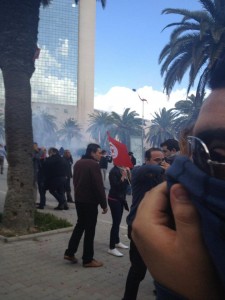This post is part of our special coverage Tunisia Revolution 2011.
Tunisia's netizens and activist community were shocked on April 9, 2012, by the police response to a planned protest to mark Martyrs’ Day. It came a day after a smaller protest by jobless young people was attacked by the police.
The protesters planned to challenge the ban on protesting on Habib Bourguiba Avenue by starting their demonstration on Mohamed V Avenue. Police responded by using tear gas, batons and electric batons to disperse them. Some members of the National Constituent Assembly, journalists, bloggers, lawyers and activists were harshly beaten. Netizens expressed their anger, shock and sense of déja-vu.

Protesters encircled by police in Tunis on April 9, 2012. Image by Flickr user Amine Ghrabi (CC BY-NC-SA 2.0).
Global Voices author Afef Abrougui tweeted:
Twitter user Tunisienne Libre (@Fleursdecactus) tweeted that the aggression spread to other streets:
@Fleursdecactus: C'est le chaos à Jean Jaures, av. de Paris, rue de Marseille… Poursuites, agressions, lacrymo.

Police clash with protesters at Mohamed V Avenue in Tunis. Image by Lina Ben Mhenni (CC BY-NC-ND 3.0).
Slim Amamou, prominent blogger and founder of the Tunisian Pirate Party, described the situation:
@slim404: #9avril Le nombre de bras fracturés est anormal. Il y a qlq chose qui a changé dans l'équipement ou les méthodes de la police
Fatma Riahi, alias Fatma Arabicca, a prominent blogger and the co-founder of the Association of Tunisian Bloggers, was beaten by riot police and hospitalized. In this video [ar] she explained what happened:
Afef Abrougui criticized the government's justification for banning protests on Habib Bourguiba Avenue, which was to protect businesses and attract tourists:
@AfefTN: protesters, MPs, journalists, activists & paramedics were assaulted 2day in #Tunis | a good way to attract tourists u gov of fools #9avril
Blogger Keyser Söze wrote a post entitled “Pandora's Box”:
Le 9 avril 2012 restera un jour triste dans la mémoire de tout tunisien. Il portera à jamais la marque de l’ingratitude des autocrates en poste envers le peuple qui les a libérés.
He added:
Toute la panoplie de la répression de l’aire dictatoriale a été employée pour casser du Tunisien. Ils ont même eu recours à l’aide de milices inconnues comme à la belle époque.
The following YouTube video by TunisiaTalks shows police chasing protesters and their brutality towards them.
Mustapha Ben Jafar, the President of the National Constituent Assembly asked the government [fr] to begin an investigation to find out who was responsible. On television the president Moncef Marzouki apologised for the high level of violence employed against protestors.
This post is part of our special coverage Tunisia Revolution 2011.











7 comments
its very sad that the police of a country take such drastic measures for such a minimal and harmless protest. these things are when the people of all countries need to stick together to rise above the oppression